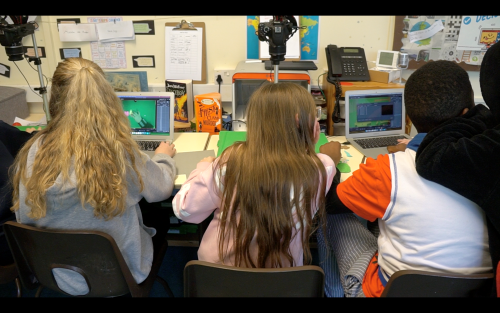The idea behind ENGAGE

ENGAGE was a creative project funded by the Ingenious public engagement grants scheme to empower local children from Llanmartin Primary School (Newport) and Mount Stuart Primary School (Cardiff Bay) with new skills and team up with engineers from Cardiff and Swansea universities and local animators to turn big engineering ideas into animations.
Dr Phillip Lugg-Widger, project lead and lecturer at the School of Engineering, Cardiff University, says: "We set up a collaboration between Cardiff and Swansea universities, local animators, and engineers - with two primary schools, to co-create short animations that explain real engineering topics. " He adds, "one of the main focuses of the videos was that they were both in English and Welsh."
From engineering labs to inspiring animations
The journey began with visits to Cardiff and Swansea engineering labs to learn about the research and see the kind of work they do in sustainable engineering and future technologies.
Back at school, local animators first taught animation skills and then supported children to develop their own storyboard, visuals, voiceovers, script and full animations. “They went back to their schools for an eight-week course led by us and the animators - creating their own characters and developing full stories around engineering topics before finally getting hands-on with the cameras.” Phillip adds, “the final animations were showcased at local school assemblies. It really widened the impact. From the pupils to their peers, and then outwards to the public.”
Breaking down barriers for pupils and engineers
ENGAGE was designed to be inclusive from the start. The project reached around 400 pupils overall, with 40 children directly creating the animations. Both schools serve diverse communities, and the creative route into science made the activities accessible to children who might usually lean towards arts subjects. One child reflected in their questionnaire: “It’s really fun and had loads of teamwork.” Another wrote: “I learnt a lot about heat from my animation but also a lot from my other classmates' animations.”
Engineers benefited too. Sixteen engineers took part - from Cardiff and Swansea universities and industry - with a high number of participating female engineers. Together they showed the diversity of engineering and the many paths into it, from civil, mechanical, electrical and sustainable energy.

“We ran skills workshops before the school sessions to train them in equality, diversity and inclusion, and how to engage with children,” Phillip continues. “The training helped engineers explain their work using words that children understand, words that really mean something to them, paired with visuals and demos.”
These training sessions also challenged stereotypes. Phillip explains: “We looked at how to overcome engineering stereotypes and engage equally with the local community. The two schools are wonderfully diverse, and that made the experience even richer.”
Post-project surveys reported that 100% of respondents agreed or strongly agreed that the project increased their understanding of the challenges in engaging under-served audiences, and seven out of eight reported greater confidence to do outreach. Engineers mentioned a wide range of knowledge, from the training, that they found particularly useful, such as barriers for young people, using diverse voices, and equitable classroom practices. As one engineer puts it, “I found the reframing of narratives really interesting and useful. There were definitely some things discussed that I hadn't thought of before.”
A proud premiere and a growing audience
The final animations were unveiled at school assemblies and have since appeared at public events including Cardiff Museum After Dark, the National Eisteddfod and Swansea Science Festival, introducing people to engineering ideas through the pupils’ own words and drawings.
“The topics covered everything from the future electricity grid and sustainable transport to active buildings and manufacturing technologies. A whole range of civil, mechanical and electrical engineering,” Phillip adds. “It’s amazing seeing children explaining engineering to other children in their own words.”
Challenges and lessons
Not everything was straightforward, but that has meant lots of useful learnings for future projects. “Creating eight different animation videos on the project timescale was challenging. We ran sixteen workshops, plus lab visits and showcase events, all while taking children from no animation experience to producing full two-minute films.” Phillip reflects, “building relationships between universities, industry and local animators also takes time. It is important to factor in timescales before you can expect to start running engagement activities, especially in settings such as schools.”
Legacy and next steps
“We’ve focused since on developing classroom resources from the videos to structured activities teachers can use.” Phillip continues. “We’re applying for the Ingenious follow-on fund to develop bilingual resources for schools in Wales, so that children studying only in Welsh aren’t cut off. We now have fifteen different engineering animation topics, covering a diverse range of themes to speak to different audiences.”
The next phase will also make it easier to meet engineers without a lab visit: “The idea is to have an engineer appear alongside each animation, explaining the topic they work on day to day, so even if pupils can’t visit a lab, they can still meet the engineers through video.” Phillip explains.
Advice for future Ingenious projects
“Plan how you will scale up activities, build links with different communities and factor in time.” Phillip advises, “it is useful to have a clear step-by-step process from start to finish but be ready to adapt as things change quickly in delivery. If something doesn’t work, have a backup in place or other communities you can engage with, so you still achieve the outcomes you set out for. Challenging stereotypes and engaging with engineering topics through alternative mediums with diverse communities is incredibly rewarding for all involved.”
Watch the Engineering Animations (ENGAGE) Highlights
More stories

Engineering Meets Dance
Brought together engineers from the University of Leeds, artists from Northern Ballet, educators, and young people from Batley Girls’ High School to explore the mechanics of movement through dance.

Maritime engineering
As part of W5's Regatta challenge, six school teams sailed their hand-crafted cardboard boats in the Lagan River in Belfast.
